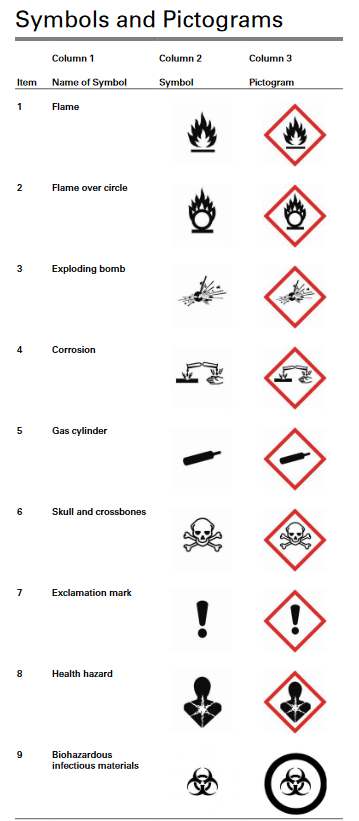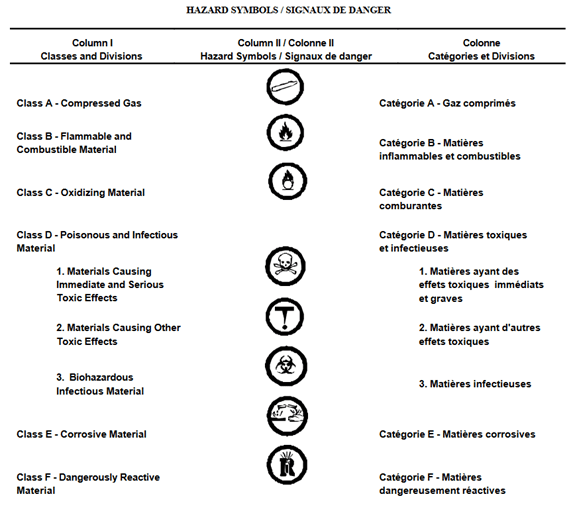WHMIS 1988 Symbols versus GHS Pictograms – Why are we still seeing these on labels and SDSs?
By: Teah Jazey, Regulatory Affairs & Product Safety Associate
Some of the most popular questions we receive at Dell Tech relate to product compliance and workplace health and safety for chemicals: Is my SDS compliant in Canada? Is my label compliant for the Canadian workplace? And we see a lot of confusion about WHMIS 1988 and WHMIS 2015 symbols, especially old symbols and safety data sheets.
If you’re asking yourself, or perhaps the internet, these same questions – this article is for you. Read until the end to get expert guidance for Health Canada compliance, WHMIS and your safety data sheets.
WHMIS 1988 Symbols and Section 15 of Material Safety Data Sheets
When products are being imported for sale in Canada, we must check the safety data sheet Section 15: Regulatory Information. This is where we find the old Workplace Hazardous Materials Information System symbols. If we see WHMIS 1988 symbols, it tells us that the SDS is based on the Controlled Products Regulations (CPR), a set of regulations that has since been repealed.
Despite regulatory changes, including WHMIS 2015, we still see WHIS 1998 symbols, referencing that the product is “in compliance with the CPR”.
If you see this on a product that you are importing into Canada, STOP. Ask your international supplier for an SDS that is compliant with the Hazardous Products Regulations (HPR) and ensure that the SDS is using GHS Version 5 hazard statement(s) and symbols.
WHMIS 1988 symbols vs GHS pictograms – Is my SDS and label compliant for Canada?
When the new regulations, WHMIS 2015, came into effect in Canada, we moved over to a different set of symbol requirements. These are referred to as Symbols and Pictograms. Under the new Hazardous Products Regulations (HPR), they can be found in Schedule 3 of the current regulations.
There are some consistencies between WHMIS 1988 and WHMIS 2015 with the ‘picture’ requirements. But now, pictures are no longer within a circle and there is the color component, red.
Note: biohazardous infectious materials are still within a circle.
In these new regulations, there are different symbols available for us to use such as the health hazard. The classes and divisions are also a big difference, the GHS/WHMIS 2015 do not use these classifications anymore.
What is Canada Using Now – GHS Pictograms
Canada is currently using Globally Harmonized System (GHS) Version 5. The hazard statements are different than the US, GHS Version 3 statements. It is imperative that the appropriate phrases and pictograms are being used on Canadian safety data sheets.
It is important to know that Canada is moving to Version 7 of GHS, which comes into effect December 15, 2025. Until then, ensure you do have appropriate phrases and labels for use within Canada.
As mentioned above, Schedule 3 in the Hazardous Products Regulations outlines the current symbols and pictograms that must be used on any SDS or label, where relevant. The below images depict the 9 hazard classes found in the current GHS revision.
These symbols cover different classifications than the previously used WHMIS 1988/CPR. For example, the corrosive symbol will apply to products that belong to the hazard class skin corrosive, eye corrosive or corrosive to metals.
The exclamation mark is used for several hazard classes including:
- eye irritation
- skin irritation
- acute toxicity
- skin/respiratory sensitizer
It is important to use the correct pictogram for the hazard that is present. As mentioned previously, you’ll see that the Biohazardous symbol has not changed with the updated regulations. This is the only symbol that has remained the same.
The WHMIS 1988 Symbols
The older WHMIS 1988 hazard symbols were found in Schedule II of the Controlled Products Regulations (CPR). These symbols were circular, black and white, and they were used for classification and labelling of Class A through Class F. The label was enclosed within a demarcated, hatched border. Within the symbol was a picture that was indicative of the classification.
Please review the below images. If you see these symbols on your current labels or safety data sheets intended for use in Canada, you must update your safety data sheets and ensure other required label elements are are compliant immediately. The CPR is no longer in use in Canada, meaning these symbols were revoked when the GHS regulations came into effect in Canada.
Contact Dell Tech to review and author compliant safety data sheets. Our team provides safety data sheet authoring for Canada and the United States, in English, Canadian French and Spanish.
Why are Pictograms Important?
Pictograms are one of the easiest ways a worker is able to identify hazards associated with a specific product. Examples of pictograms include, but are not limited to:
- flame pictogram – example: substances and mixtures which, in contact with water, emit flammable gases (Category 1, 2 and 3)
- skull and crossbones pictogram – example: acute toxicity
- exploding bomb pictogram – example: self-reactive substances
- health hazard pictogram – example: aspiration hazard
Workers only need to look at the product label or review the first few pages of the SDS to recognize a potential hazard. Section 2 in the SDS must show all the hazard pictograms that are applicable to the product that is going to be used. Also found in Section 2 are the matching precautionary statements for that hazard.
A workplace should always have SDSs for each product that is found in the workplace to allow the worker quick access to hazard identification and safety information. This is an important component of health and safety for all workplaces, including federally regulated workplaces.
How Dell Tech Can Help with WHMIS Compliance
If you have any questions regarding current Workplace Hazardous Materials Information System, the difference between WHMIS 1988 and WHMIS 2015, safety data sheet or label requirements, do not hesitate to reach out to the team at Dell Tech. We can help you convert your older MSDSs into SDSs that use the appropriate symbol not only on your SDS but also on your labels. Contact us for further information on how we can help you meet your product compliance with the GHS (Globally Harmonized System)!
For More Information, Contact Client Services:
Kim Samela
Client Services Coordinator
519-858-5021
kim@delltech.com
Dell Tech has provided professional, confidential consulting services to the specialty chemical
industry in Canada, the USA, Europe, and Asia for the last 40 years.
Contact us today for more information.






